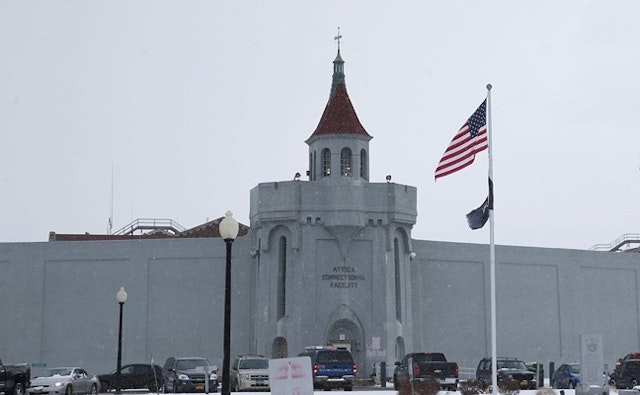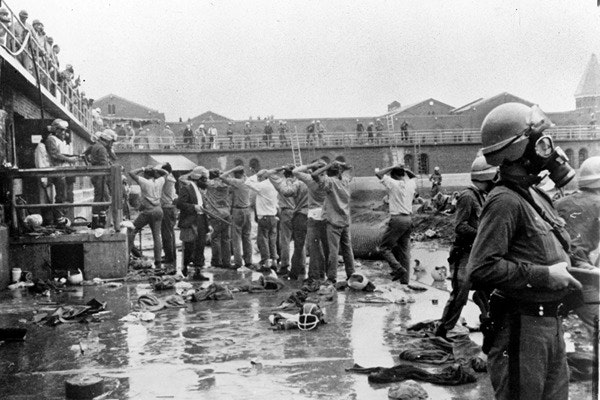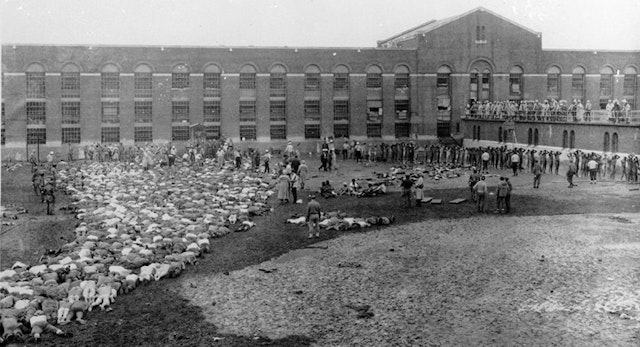Uprising at Attica prison begins
September 09 1971

Prisoners seize control of the maximum-security Attica Correctional Facility near Buffalo, New York beginning on September 9, 1971. Later that day, state police retook most of the prison, but 1,281 convicts occupied an exercise field called D Yard, where they held 39 prison guards and employees hostage for four days. After negotiations stalled, state police and prison officers launched a disastrous raid on September 13, in which 10 hostages and 29 inmates were killed in an indiscriminate hail of gunfire. Eighty-nine others were seriously injured.
By the summer of 1971, the state prison in Attica, New York, was ready to explode. Inmates were frustrated with chronic overcrowding, censorship of letters and living conditions that limited them to one shower per week and one roll of toilet paper each month. Some Attica prisoners began to perceive themselves as political prisoners rather than convicted criminals.
On the morning of September 9, the eruption came when inmates on the way to breakfast overpowered their guards and stormed down a prison gallery in a spontaneous uprising. They broke through a faulty gate and into a central area known as Times Square, which gave them access to all the cellblocks. Many of the prison’s 2,200 inmates then joined in the rioting, and prisoners rampaged through the facility beating guards, acquiring makeshift weapons and burning down the prison chapel. One guard, William Quinn, was severely beaten and thrown out a second-story window. Two days later, he died in a hospital from his injuries.

Using tear gas and submachine guns, state police regained control of three of the four cellblocks held by the inmates without loss of life. By 10:30 a.m., the inmates were only in control of D Yard, a large, open exercise field surrounded by 35-foot walls and overlooked by gun towers. Thirty-nine hostages, mostly guards and a few other prison employees, were blindfolded and held in a tight circle. Inmates armed with clubs and knives guarded the hostages closely.
Leaders of the uprising put together a list of demands, including improved living conditions, more religious freedom an end to mail censorship and expanded phone privileges. They also called for specific individuals, such as U.S. Representative Herman Badillo and New York Times columnist Tom Wicker, to serve as negotiators and civilian observers. Meanwhile, hundreds of state troopers arrived at Attica, and New York Governor Nelson A. Rockefeller called in the National Guard.
In tense negotiations, New York Correction Commissioner Russell Oswald agreed to honor the inmates’ demands for improved living conditions. However, talks bogged down when the prisoners called for amnesty for everyone in D Yard, along with safe passage to a “non-imperialist country” for anyone who desired it. Observers pleaded with Governor Rockefeller to come to Attica as a show of good faith, but he refused and instead ordered the prison to be retaken by force.

On the rainy Monday morning of September 13, an ultimatum was read to the inmates, calling on them to surrender. They responded by putting knives against the hostages’ throats. At 9:46 a.m., helicopters flew over the yard, dropping tear gas as state police and correction officers stormed in with guns blazing. The police fired 3,000 rounds into the tear gas haze, killing 29 inmates and 10 of the hostages and wounding 89. Most were shot in the initial indiscriminate barrage of gunfire, but other prisoners were shot or killed after they surrendered. An emergency medical technician recalled seeing a wounded prisoner, lying on the ground, shot several times in the head by a state trooper. Another prisoner was shot seven times and then ordered to crawl along the ground. When he didn’t move fast enough, an officer kicked him. Many others were savagely beaten.
In the aftermath of the bloody raid, authorities said the inmates had killed the slain hostages by slitting their throats. One hostage was said to have been castrated. However, autopsies showed that these charges were false and that all 10 hostages had been shot to death by police. The attempted cover-up increased public condemnation of the raid and prompted a Congressional investigation.
The Attica uprising was the worst prison riot in U.S. history. A total of 43 people were killed, including the 39 killed in the raid, guard William Quinn, and three inmates killed by other prisoners early in the riot. In the week after its conclusion, police engaged in brutal reprisals against the prisoners, forcing them to run a gauntlet of nightsticks and crawl naked across broken glass, among other tortures. The many injured inmates received substandard medical treatment, if any.
In 1974, lawyers representing the 1,281 inmates filed a $2.8 billion class-action lawsuit against prison and state officials. It took 18 years before the suit came to trial, and five more years to reach the damages phase, delays that were the fault of a lower-court judge opposed to the case. In January 2000, New York State and the former and current inmates settled for $8 million, which was divided unevenly among about 500 inmates, depending on the severity of their suffering during the raid and the weeks following.
Families of the slain correction officers lost their right to sue by accepting the modest death-benefit checks sent to them by the state. The hostages who survived likewise lost their right to sue by cashing their paychecks. Both groups attest that no state officials apprised them of their legal rights, and they were denied compensation that New York should have paid to them.
source: history.com |